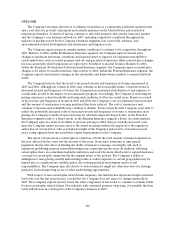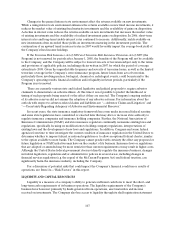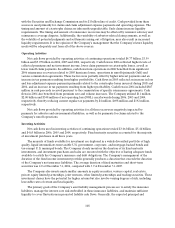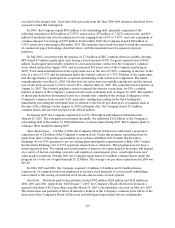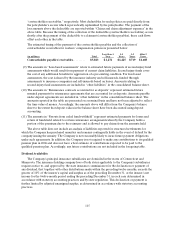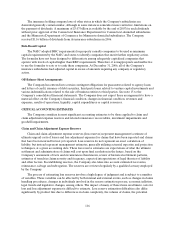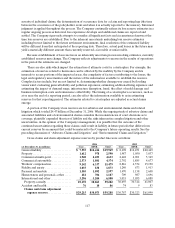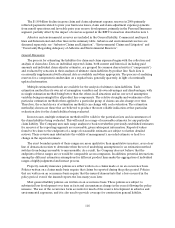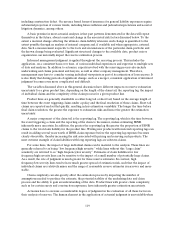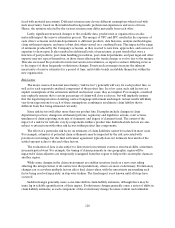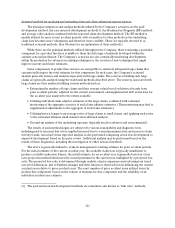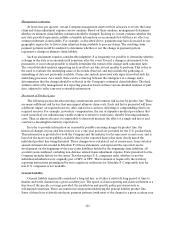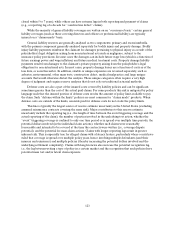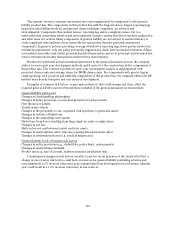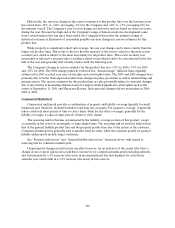Travelers 2006 Annual Report Download - page 128
Download and view the complete annual report
Please find page 128 of the 2006 Travelers annual report below. You can navigate through the pages in the report by either clicking on the pages listed below, or by using the keyword search tool below to find specific information within the annual report.116
The insurance holding company laws of other states in which the Company’s subsidiaries are
domiciled generally contain similar, although in some instances somewhat more restrictive, limitations on
the payment of dividends. A maximum of $3.07 billion is available by the end of 2007 for such dividends
without prior approval of the Connecticut Insurance Department for Connecticut-domiciled subsidiaries
and the Minnesota Department of Commerce for Minnesota-domiciled subsidiaries. The Company
received $1.16 billion of dividends from its insurance subsidiaries in 2006.
Risk-Based Capital
The NAIC adopted RBC requirements for property casualty companies to be used as minimum
capital requirements by the NAIC and states to identify companies that merit further regulatory action.
The formulas have not been designed to differentiate among adequately capitalized companies that
operate with levels of capital higher than RBC requirements. Therefore, it is inappropriate and ineffective
to use the formulas to rate or to rank these companies. At December 31, 2006, all of the Company’s
insurancesubsidiaries had adjusted capital in excess of amounts requiring any company or regulatory
action.
Off-Balance Sheet Arrangements
The Company has entered into certain contingent obligations for guarantees related to agency loans
and letters of credit, issuance of debt securities, third party loans related to venture capital investments and
various indemnifications related to the sale of business entities to third parties. See note 15 to the
Company’s consolidated financial statements. The Company does not expect these arrangements to have a
material effect on the Company’s financial condition, changes in financial condition, revenues and
expenses, results of operations, liquidity, capital expenditures or capital resources.
CRITICAL ACCOUNTING ESTIMATES
The Company considers its most significant accounting estimates to be those applied to claim and
claim adjustment expense reserves andrelated reinsurance recoverables, investment impairments and
goodwill impairments.
Claim and Claim Adjustment Expense Reserves
Claim and claim adjustment expense reserves (loss reserves) represent management’s estimate of
ultimate unpaid costs of losses and loss adjustment expenses for claims that have been reported and claims
that have been incurred but not yet reported. Loss reserves do not represent an exact calculation of
liability, but instead represent management estimates, generally utilizing actuarial expertise andprojection
techniques, at a given accounting date. These loss reserve estimates areexpectations of what the ultimate
settlement and administration of claims will cost upon final resolution in the future, based on the
Company’s assessment of facts and circumstances then known, review of historical settlement patterns,
estimates of trends in claims severity and frequency, expected interpretations of legal theories of liability
and other factors. In establishing reserves, the Company also takes into account estimated recoveries,
reinsurance, salvage and subrogation. The reserves are reviewed regularly by a qualified actuary employed
by the Company.
The process of estimating loss reserves involves a high degree of judgment and is subject to a number
of variables. These variables can be affected by both internal and external events, such as changes in claims
handling procedures, changes in individuals involved in the reserve estimation process, economic inflation,
legal trends and legislative changes, among others. The impact of many of these items on ultimate costs for
loss and loss adjustment expenses is difficult to estimate. Loss reserve estimation difficulties also differ
significantly by product line due to differences in claim complexity, the volume of claims, the potential


